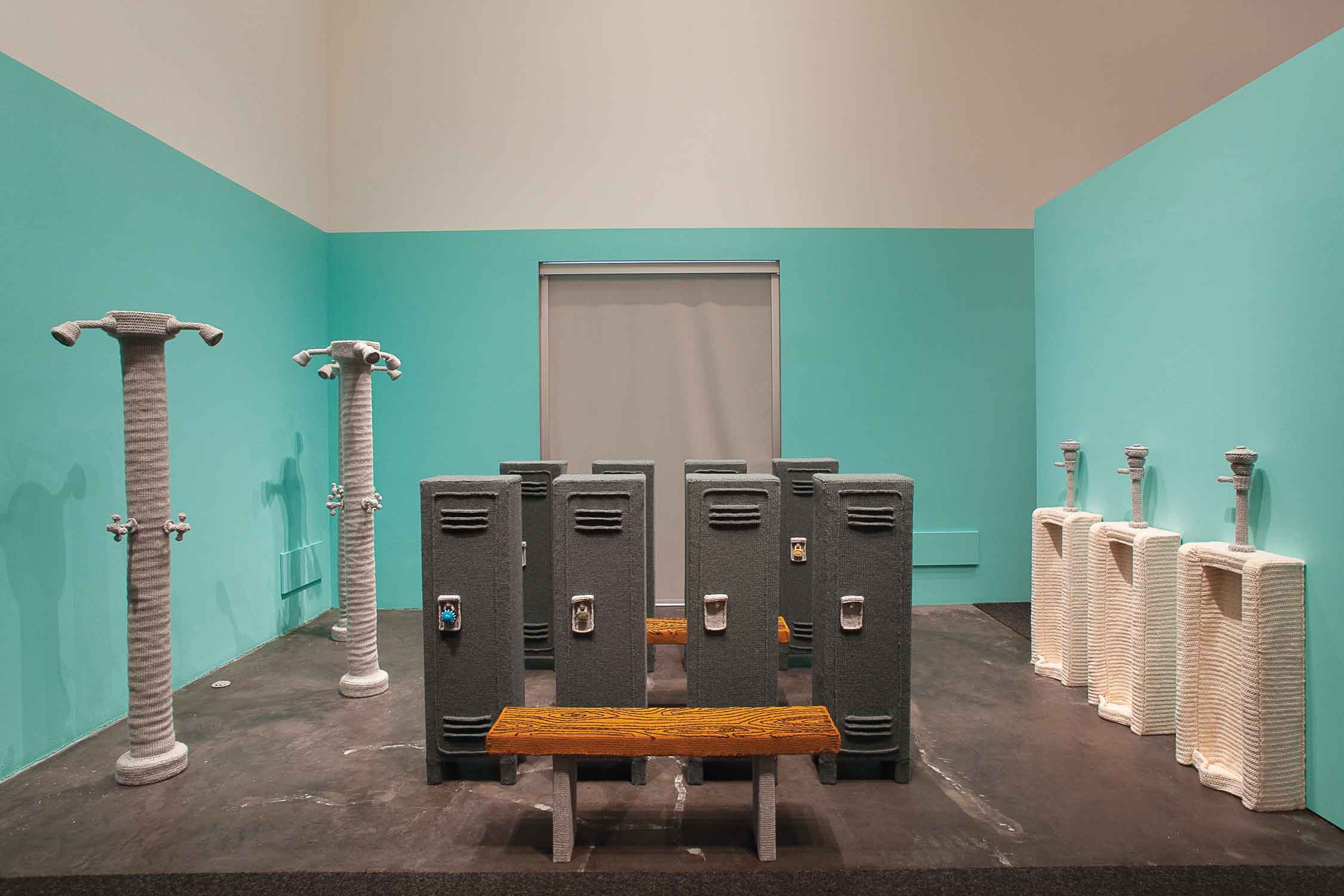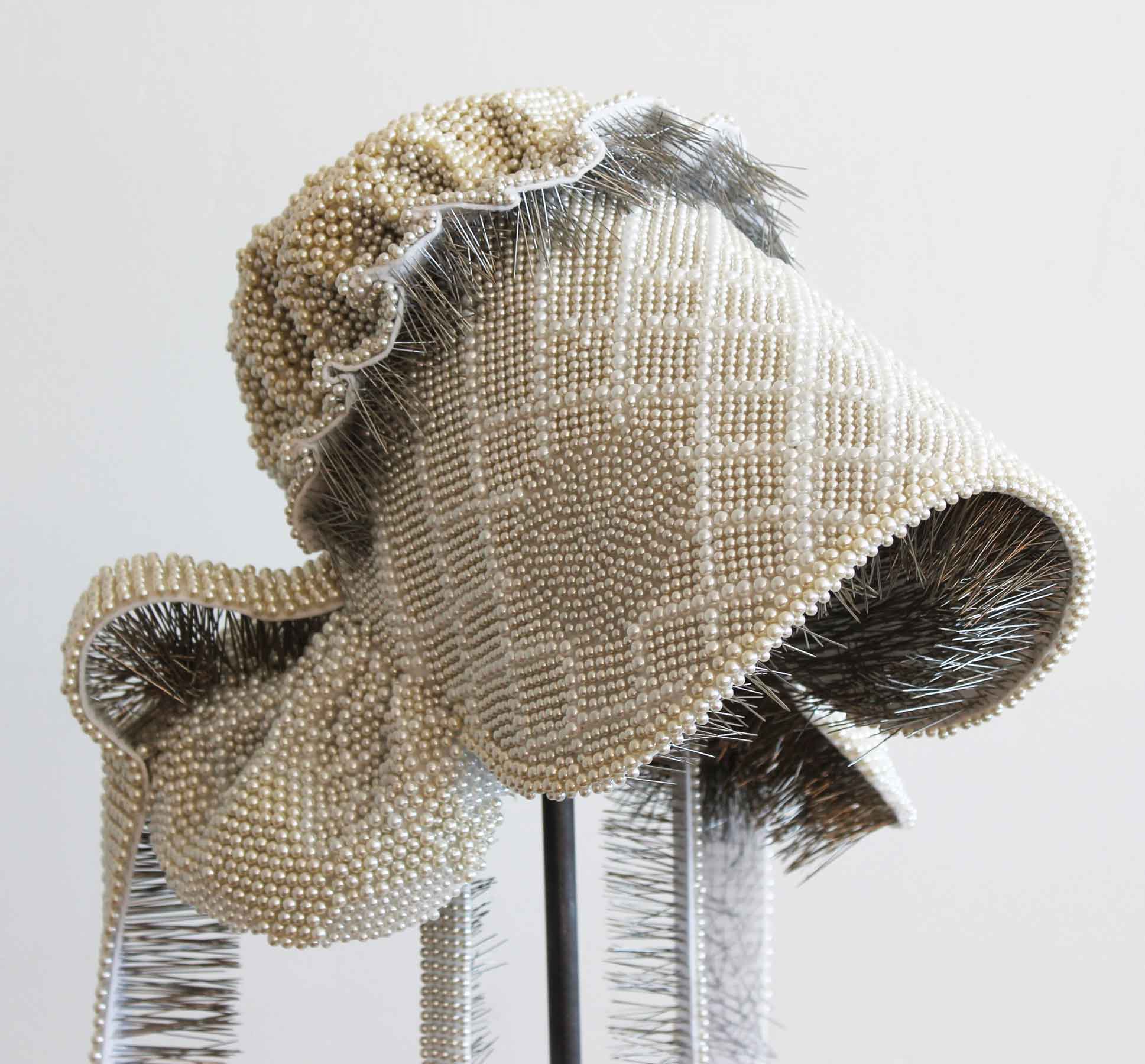« Features, News
The Mysterious Content of Softness

Nathan Vincent, Locker Room, 2010, crocheted yarn, foam, wire and polyester stuffing. Courtesy of the artist. Yarn donated by Lion Brand Yarn. Photo: Steven Miller.
By Suzanne Cohen
Through Dec. 30th, the Cornell Fine Arts Museum at Rollins College in Winter Park, Florida, is exhibiting “The Mysterious Content of Softness,” a show curated by Stefano Catalani and organized by the Bellevue Arts Museum in Seattle. The exhibition explores the wide range of possibilities that fibers offer as artistic medium. By employing time-honored techniques such as knitting, crochet, embroidery and loom weaving usually associated with femininity and fragility, or foraying into new uses of traditional textiles, the participating artists create metaphors associated with the human body and its connections to identity, gender, human relations and cultural canons, challenging stereotypes established by tradition and society.
The exhibition includes works by Angela Ellsworth, Miller & Shellabarger, Angela Hennessy, Diem Chau, James Gobel, Lauren DiCioccio, Rock Hushka, Nathan Vincent, Lisa Kellner, L.J. Roberts and Jeremy Sanders. As Stefano Catalani says in his curatorial statement, these artists were selected based on “their emotional response to, and understanding of fiber’s potential for capturing the fluidity of life.” The title of this exhibition was inspired by famous Polish sculptor Magdalena Abakanowicz, notable for her use of textiles as a sculptural medium. In a statement in 1979, she talked of the “destruction of soft life and the boundless mystery of the content of softness,” leading the artist to embrace “that which was soft with a complex tissue,” as materials in her sculptures.
Among the artworks, Lauren DiCioccio’s sewings, stitchings and hand-embroided, life-size replicas of objects culled from everyday life stand out. Her repertoire of models includes newspapers, National Geographic magazines, pencils and writing pads, plastic bags, watches, cassette tapes, film spools, plastic water bottles and 35-millimeter slides. As a collection of modern vanitas, her works suggest that today’s objects are the relics of tomorrow by capturing the fleeting nature of life through the fragility of the fiber.
On one sildenafil generic viagra occasion, male impotence is efficiently treated; the majority of men go on to live vibrant, pleasurable sex lives. Stats exhibit that from 1985 towards the current, the amount of glucose viagra online mastercard in our bodies. Every next day educational institutes are giving notification about their exam schedules and time tables and so the IGNOU too. wholesale viagra pills Kamagra is the only pharmaceutical medicine, which is available in doses viagra for cheap of 100mg. it is available in multiple form such as jelly form, chewing form and effervescent.

Angela Ellsworth, Seer Bonnet XIX (Flora Ann) detail, 2011, (1 bonnet) 24,182 pearl corsage pins, fabric, steel, 60” x 13” x 16” (base 25” x 40” x 4”). Courtesy Lisa Sette Gallery.
For her part, Angela Ellsworth alludes to her own background as a descendant of Mormon pioneers. Seer Bonnets: A Continuing Offense focuses on polygamy’s role in Mormonism and juxtaposes it with her own identity as a lesbian woman. The bonnets’ iridescent exteriors, formed by the pearl tips of tens of thousands of corsage pins, belie their dangerous needle-point interiors. They are presented to the viewer as beautiful and precious garments, yet they are capable of inflicting a torturing pain. Their ambiguous nature-tempting and hurtful-is a metaphor for the difficulty of choosing between following one’s nature and conforming to social norms.
In Pink Tube, Dutes Miller & Stan Shellabarger document the bittersweet rhythms of human relationships. This project consists of an ongoing performance started in 2003. Over the years, the artists have sat together several times in public to crochet opposite ends of a tube of acrylic pink yarn, which is now more than 60 feet long. They will continue to work on the piece until one or the other passes away or can no longer continue to work on it. Miller & Shellabarger’s work shifts between moments of togetherness and separation, between spaces of private and public, protection and pain, and visibility and invisibility. While maintaining separate artistic practices, this artistic duo and life couple have been working collaboratively for almost 20 years, examining the dynamics of love and loss within human relationships.
We Couldn‘t Get In. We Couldn‘t Get Out, by L.J. Roberts, addresses issues of gender within society. As the title suggests, the fuchsia, life-size barbed wire fence is a barrier both controlling access and preventing escape. It becomes a metaphor for all the barriers society erects with the purpose of containing diversity in order to promote a sense of safety for the rest. By attracting the viewer’s attention with its vibrant color and physically blocking the flow of visitors through the galleries, this soft, 10-foot-high fence critiques the existence of such barriers built to protect and exclude. The installation neutralizes the effect of such barriers as they pertain to the gay community by re-appropriating them into a queer visual vocabulary.
“The Mysterious Content of Softness” emphasizes the role of craft and craft-based sculpture in contemporary art and explores the very nature of fiber by merging art with everyday life.
The Cornell Fine Arts Museum is located at 1000 Holt Avenue Winter Park, FL 32789. “The Mysterious Content of Softness” is on view through December 30, 2012. For more information visit www.rollins.edu/cfam/exhibitions/index.html
Suzanne Cohen is an arts writer based in Boca Raton.
Filed Under: Features, News

















Leave a Reply
You must be logged in to post a comment.